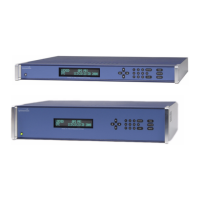XLi Time & Frequency System 69
XLi-man, Issue 8, 6/17/2008, Rev. H
2
5
1
SSSSSSSSSSSS SSSSSSSSSS SSSSSSS S SSS S SSSSS S
The Time On Demand string contains an additional four characters representing the decimal point and
milliseconds of the Local Time at the time of receipt of the 'T'.
Exit F27 B<N> TD mode by entering a ^C or Ctrl+C.
F42 – Multicode Output Configuration
Use function F42 to view or set up the time-code outputs of the Multicode Output (87-6002-
XL1) (page 171).
• Board #: Identifies the card to which the following settings will apply. (Select between multiple
cards using the UP/DOWN ARROWs buttons on the keypad). The card number is determined by
the position of DIP switches on the Multicode card. Each card must have a unique number. (See
“Installation” on page 171)
• Output #: Identifies the output to which the settings apply (e.g., J1 through J4)
• Code: The time code output by the port. The note below provides a complete list of all the time
code types available.
• Time Reference: The type of time (e.g., UTC, Standard, Local, GPS) output by all ports on the
card. Even though this setting is shown for a specific output, it sets the type of time for all ports.
Notes:
• The code output types include: IRIG-A 130, IRIG-A 133, IRIG-B 120, IRIG-B 123, IRIG-E 111,
IRIG-E 112, IRIG-E 121, IRIG-E 122, IRIG-G 141, IRIG-G 142, IRIG-H 111, IRIG-H 112, IRIG-H
121, IRIG-H 122, 2137, XR3, NASA 36.
• If IRIG-A 130 or IRIG-A 133 is selected as the output type for a specific port, all other ports set for
IRIG-A will be ‘bumped’ to the same type (130 vs. 133). Ports set to other time code types (e.g.,
IRIG-B) are not affected.
• The same is true for IRIG-G. If IRIG-G 141 or IRIG-G 142 is selected as the output type, all the
other ports set for IRIG-G will be ‘bumped’ to the same type (141 vs. 142). Ports set to other time
code types (e.g., IRIG-B) are not affected.
• For more information on the code output types, see “E: Time Code Formats” on page 287.
• For Time Reference, the following is a summary explanation of the different types of time:
- UTC (Coordinated Universal Time) differs from GPS Time by the addition of leap-second cor-
rections to compensate for variations in the earth’s rotation.
- GPS time is derived directly from the GPS constellation. It doesn’t contain leap-second
adjustments or other GPS-to-UTC corrections.
- Standard time is UTC plus a time zone adjustment. For example, Pacific Standard Time is
UTC minus 8 hours. See “F: World Map of Time Zones:” on page 291
for more information.
- Local time is UTC plus a time zone adjustment and a Daylight Saving Time adjustment.
•See “F69 – Time Mode” on page 89
for an expanded explanation of the different types of time.
Note, however, that F69 does not affect F42 or the Multicode Output card.
Artisan Technology Group - Quality Instrumentation ... Guaranteed | (888) 88-SOURCE | www.artisantg.com

